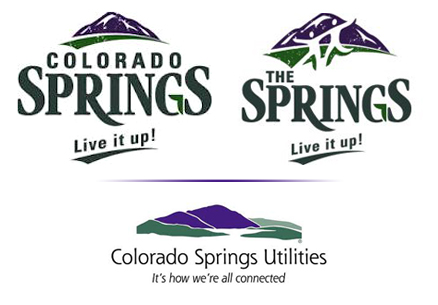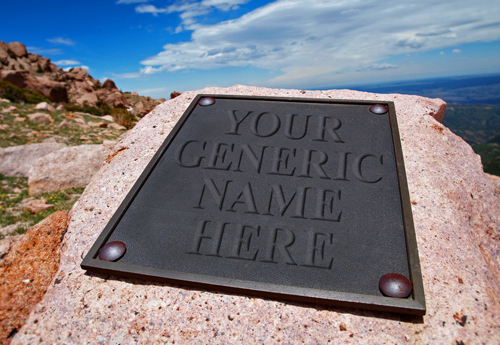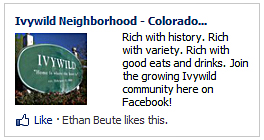In Colorado Springs, a place I’ve called home for more than 5 years now, community leaders recently gathered and consultants were hired to create a branding campaign for the city. The targets: “residents, tourists, and the business community.”
I love a good internal branding effort – one that gathers stakeholders, is facilitated by an outside party, and results in self-discovered essence and difference. I didn’t balk at the $110,000 price tag, as many have. The fruit:
- Brand Essence: Alive
- Brand Truth: Living Means Doing
- Brand Character: Rugged, Vibrant, and Exceptional
Great! I’m with ’em so far. I can’t say it’s all that unique, but it does fit.
The key deliverables were unveiled on Tuesday afternoon – a logo, slogan, and video. The language from the head of the CVB at the press conference was a bit stiff, including the idea that it had to “differentiate us from the competition.” Ready? Live It Up, Colorado Springs!
Beyond the self-congratulatory whooping of those directly involved, reception of the logo, slogan, and video was not especially favorable.
- The Denver Egoist immediately jumped on it, noting that 7 other cities are using the same slogan (NOTE: Battle Creek, Michigan is among them)
- The Colorado Springs Convention and Visitors Bureau posted the video on its Facebook page and asked for comments. 22 comments later, the video was removed because the feedback turned ugly (NOTE: I strongly discourage this move – if negative things are being said, you should be hosting that conversation!)
- Within 24 hours, a new Facebook page, Rebrand The Springs, was created and calling for another go at the campaign by local artists (NOTE: if local people were not used to create the logo and video, as has been suggested, shame on the CVB!)
- If you Google “Colorado Springs” and “Live It Up” – or just ask a handful of random locals – I expect that you’ll find plenty of other mixed and negative reviews.
THE LOGO(S):

Bad idea (above): two logos instead of one. Inspiration (below): better than Battle Creek Utilities.
THE VIDEO:
QUICK TAKE:
Again, I’m fine with brand process and the resulting essence, truth, and character, but the creative execution needs help.
For the slogan and logo, a visual reference to elevation (either 6,035ft for the city or 14,115ft for Pikes Peak) would help draw a necessary connection. Abandoning a phrase that feels extremely dated (who’s “living it up” in 2011?) by abandoning a slogan or tagline completely would have been perfectly acceptable to me. The mountain should have a much stronger resemblance to the iconic east face of Pikes Peak.
On the upside, the green and purple work for me. The colors fit and are one of the most unique features of the entire effort. They roughed up the peak a little, which implies rugged. The font choice is fine; it’s not especially common and has a little style to it.
As noted in the caption above, I abhor the idea of two logos; a logo is a logo is a logo. It can change and evolve over time, but two logos in use simultaneously is a basic branding no-no. It feels especially disjointed when both appear at the end of the video.
In the video, I see several problems, including:
- excessive length (the ending – a long, slow fade of music and logos – reinforces this by lacking any punch)
- limited style, dated style (as a radio station might say, it’s “80’s 90’s and Now!”)
- poor lighting, inconsistent lighting (dark dog park, overexposed slouching gentleman, blown out Garden of the Gods background, etc)
- a too-old-too-often cast, bad makeup (fairly or unfairly referred to by many as a “retirement community” video)
- a minority service worker toiling away in the background as two lovely ladies chat about achieving the Peak (really! happens at :45)
- an insider and moneyed vibe, as if we’re supposed to know who the people are (I do recognize about a half dozen of them)
- the city and landscape do not do enough of their own talking
To that last bullet point: a basic fault of the structure is that there’s too much saying and not enough showing and proving. The worst case is the poor kid forced to call his city “radical.” Though they used to be sufficient, boastful, superlative claims (awesome! exceptional! vibrant!) without clear support are unconvincing (especially when uncomfortably delivered). Despite several good shots and fantastic photos, this too-much-saying problem could not be overcome in the nearly 4 minute presentation.
There are many other subjective issues I have with it, but those are basics.
Stepping back, though, there’s a bigger issue. This video serves no constituency in particular. The desired takeaway is completely unclear. It seems obvious to me that if you have 3 different targets – locals, tourists, and businesses – that you need 3 different videos. Why? Because they each have unique sets of needs! One video will not serve them all and, as a result, will serve no one.
- People who live here: great things to know and share, a little lofty – interesting and impressive facts about our landscape, history, and institutions; places to visit and things to do – both ordinary and off the beaten path; specific hiking and biking trails; stuff to brag to your family and friends about
- People considering a visit: less lofty and more practical – exactly what a 3 day visit might look like in Colorado Springs; top tourist spots for kids and families; restaurants, shops, and galleries in downtown, Old Colorado City, Manitou Springs; Pikes Peak by road and rail; hiking and biking trails; museums; spots off the beaten path; proximity to Denver; DIA and COS
- People and businesses thinking about moving here: very practical, balancing lifestyle with dollars and cents – start the outline with all the top 10 types of awards received from publications like Forbes, Money, Men’s Health, and others; top institutions like the United States Olympic Committee and Olympic Training Center, the United States Air Force Academy, and The Broadmoor; Pikes Peak by road, rail, and trail; top employers like USAA, Memorial Health Systems, Compassion International, and others; a look into neighborhoods and local parks
That’s just a quick, one-pass effort at outlining videos to address the three segments’ specific needs and interests. Obviously, a ton of video would be used in all 3; it’s not a significant, multiplied effort.
THE BOTTOM LINE:
Colorado Springs has lots to love. It’s a beautiful place with a great climate, rich history, and good people. I appreciate the effort and agree with the foundational brand concepts generated.
A truly collaborative effort would have been more authentic and better received. Take the brand concepts, share them with locals, then turn them loose on logos, slogans, and videos.
What great content for a stand alone website that body of locally produced work would make!
Of course, a process that open is just as scary as negative Facebook comments.




